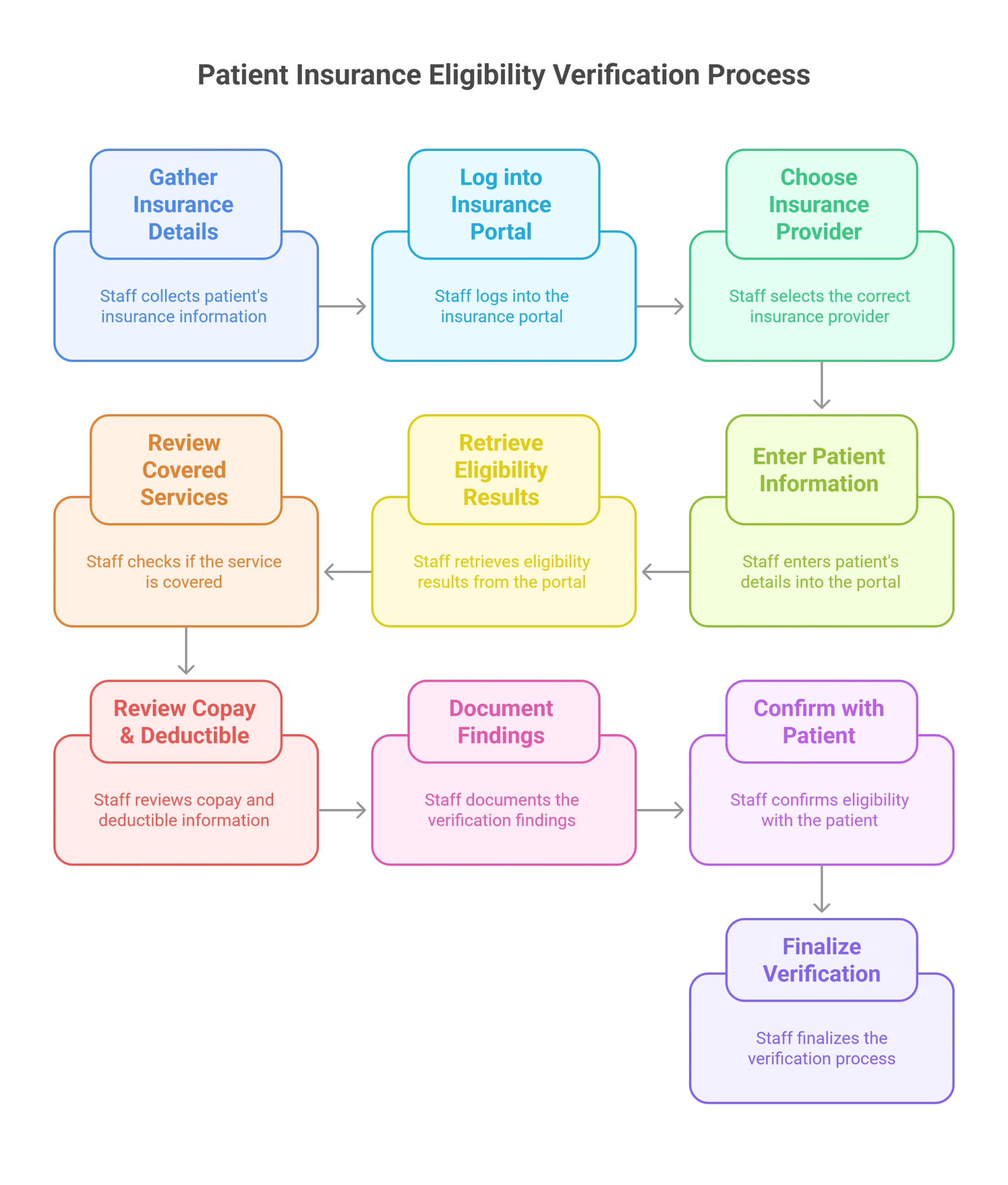On-Demand Outsourcing BPO Services for Healthcare Providers With 24/7 Coverage!
Save up to 70% on staffing costs!
Browse Specialty Staffing ServicesTraining New Staff on Insurance Eligibility Verification Common Pitfalls and How to Avoid Them?

Insurance eligibility verification is a foundational task in the medical billing process. It ensures that a patient’s insurance is active and their scheduled services are covered on the date of service. For healthcare providers, accurate eligibility verification prevents claim denials and improves the patient’s financial experience.
In this guide, we’ll walk through the full eligibility verification process with Patient A, a new patient scheduled for an internal medicine consultation. The article outlines the step-by-step process that Staffingly follows and highlights common mistakes new staff make, along with tips to avoid them.
What Is Patient Insurance Eligibility?
Insurance eligibility is the process of confirming that a patient’s health insurance is active and that the services they are scheduled to receive are covered. This includes checking the patient’s deductible, copay, coinsurance, plan type, and service coverage on a specific date.
Without proper eligibility checks, providers risk delivering services the patient’s insurance won’t pay for—leading to denied claims and unexpected out-of-pocket costs for the patient.
When Does Eligibility Verification Happen?
Eligibility should be verified before the patient’s appointment—typically during scheduling or pre-registration. This allows providers to resolve issues early and inform the patient of any financial responsibility upfront.
There are key differences depending on the type of patient:
- New Patients: Eligibility is verified from scratch. All insurance data must be confirmed and validated.
- Returning Patients: Even returning patients may have changed insurance. Staffingly always re-checks insurance when it has been more than 30 days since the last visit or if the patient indicates a change.
Step-by-Step Eligibility Verification Process: Patient A
Let’s go step by step through verifying insurance for Patient A, who is scheduled for a general internal medicine appointment.
Step 1: Gather and Enter Insurance Details
Staffingly starts by collecting insurance information during scheduling. The front-desk staff enters:
- Full name and date of birth
- Insurance provider and plan name
- Member ID and group number
- Front and back images of the insurance card
Step 2: Log into the Insurance Portal
Using portals like Availity Essentials, Navinet, or payer-specific tools, Staffingly logs in to begin the eligibility verification. This step ensures access to real-time data from the patient’s insurance company.
Step 3: Choose the Correct Insurance Provider
Staff members select the correct payer from the portal—e.g., Cigna, Aetna, or UnitedHealthcare.
Step 4: Enter Patient Information
Accurate entry is critical. Staffingly carefully inputs:
- Member ID
- Date of birth
- Patient’s last name
Step 5: Retrieve Eligibility Results
The portal retrieves eligibility results. Staff checks that coverage is active for the date of service.
Step 6: Review Covered Services
Staff confirms that the internal medicine consultation is included in the patient’s plan and whether referrals or prior authorizations are needed.

Step 7: Review Copay, Coinsurance & Deductible Info
Staff reviews:
- Remaining deductible
- Copayment amount
- Coinsurance rates
Step 8: Document the Findings
All verified details are stored in the billing or EHR system.
Step 9: Confirm With the Patient
Staff re-confirms eligibility with the patient at check-in and updates records if changes are reported.
Step 10: Finalize the Verification
The verification is marked complete, with appropriate notes added for billing and clinical staff.
Common Pitfalls and How to Avoid Them
Skipping verification for returning patients
Always re-check eligibility, even for patients you’ve seen before.
Data entry errors
Double-check key fields like member ID and DOB.
Selecting the wrong payer
Match the exact payer name on the card.Ignoring financial responsibility
Always review deductibles, copays, and coinsurance.
Forgetting to document results
Enter notes in the patient record for team visibility.
Failing to ask about secondary insurance
Ask every patient if they have other active coverage.
What Did We Learn?
Eligibility verification is essential for reducing claim denials and ensuring proper billing.
The process includes gathering patient details, verifying via a portal, reviewing benefits, and documenting results.
Mistakes like skipping verification, data entry errors, or choosing the wrong payer are common but preventable.
Ongoing staff training with real scenarios improves consistency and confidence.
What People Are Asking
Q: Should we verify eligibility for every visit?
A: Yes, especially for new patients or if it’s been more than 30 days since the last verification.
Q: What portals can be used for eligibility verification?
A: Common options include Availity, Navinet, and payer-specific websites.
Q: What happens if a patient’s insurance is inactive?
A: Staff should inform the patient immediately and offer options like rescheduling, alternate coverage, or self-pay.
Q: Can eligibility be checked automatically?
A: Yes, some EHRs and RCM platforms offer real-time or batch verification features.
Disclaimer
For informational purposes only; not applicable to specific situations.
For tailored support and professional services,
Please contact Staffingly, Inc. at (800) 489-5877
Email : support@staffingly.com.
About This Blog : This Blog is brought to you by Staffingly, Inc., a trusted name in healthcare outsourcing. The team of skilled healthcare specialists and content creators is dedicated to improving the quality and efficiency of healthcare services. The team passionate about sharing knowledge through insightful articles, blogs, and other educational resources.
 Book a Demo to Build Your Team Today!
Book a Demo to Build Your Team Today!

 Read Case Studies
Read Case Studies 



 Virtual Medical Assistants
Virtual Medical Assistants



